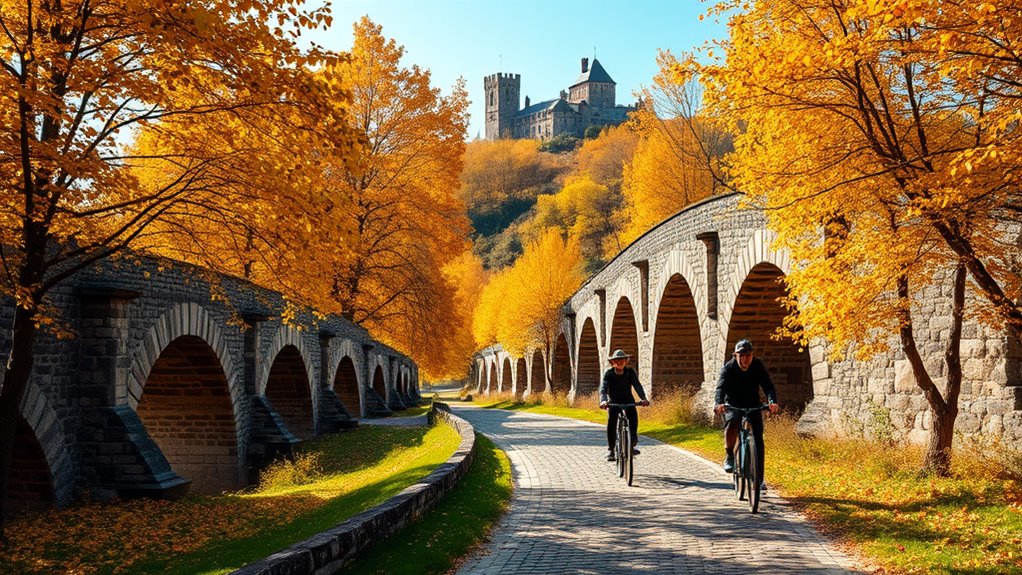Cycling through historic routes like the Ruta De La Plata and the Camino De Santiago lets you experience enchanting stories that connect you to the past. You can ride along the Via Claudia, tracing ancient Roman paths, or explore the Hadrian Cycleway, with its breathtaking views and historic forts. Each pedal immerses you in culture and history, revealing the narratives of those who came before. There’s so much more to discover about these remarkable journeys and their significance.
Key Takeaways
- Historical cycling routes like the Camino de Santiago offer a profound connection to cultural heritage and architectural wonders throughout Europe.
- The Ruta De La Plata immerses riders in ancient trade routes, showcasing significant Roman cities and cultural narratives.
- Following Hadrian’s Wall on the Hadrian Cycleway provides insights into Roman military life and picturesque Northumberland countryside views.
- Bart Verhulst’s cycling initiative honors Operation Market Garden, linking riders to World War II narratives through historical markers and personal stories.
- Notable tours in the U.S., such as Atlanta’s Journey for Civil Rights, deepen understanding of pivotal historical events and cultural heritage.
The Ruta De La Plata: a Silver Path Through Time
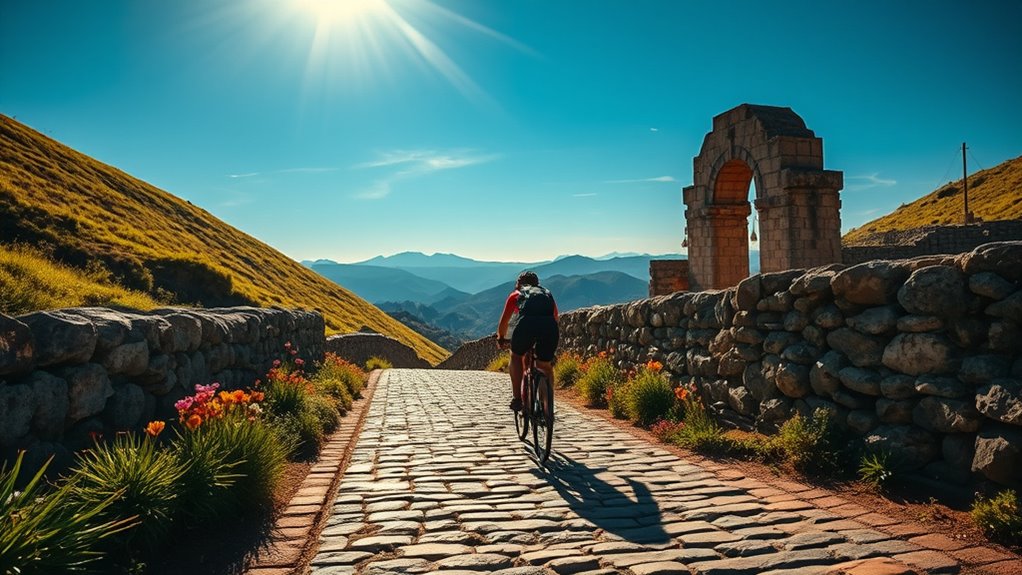
The Ruta de La Plata, or Silver Route, invites you to commence a journey through Spain’s rich history.
Originally constructed by the Romans, this path connected the Cantabrian coast to the southern regions, serving as an essential commercial and pilgrimage route.
Originally built by the Romans, this route linked the Cantabrian coast with southern Spain, vital for commerce and pilgrimage.
As you cycle along, you’ll encounter notable ancient cities like Cáceres, a UNESCO World Heritage site, and the Roman ruins in Mérida, both showcasing significant cultural heritage.
The term “Plata,” derived from the Arabic word “balat,” hints at its ancient origins.
Riding this route offers not just recreational opportunities but also a chance to immerse yourself in the historical tapestry of Spain, deepening your understanding of its diverse heritage while enjoying breathtaking landscapes. Engaging in this cycling experience can also promote mental health benefits, enhancing your overall well-being as you connect with the environment.
Via Claudia: Bridging Italy and the Roman Empire

Connecting Italy to the northern frontier of the Roman Empire, the Via Claudia stands as a memorial to ancient engineering and trade.
As you cycle this historic route, you’ll experience a blend of breathtaking landscapes and rich history.
- Journey through the snowcapped Alps and rolling vineyards.
- Explore three countries, each echoing the grandeur of the Roman Empire.
- Discover the diverse climate that nurtured significant agricultural trade.
This ancient road not only facilitated military and trade movement but also links modern cycling adventures to the past. Global economic developments have continued to shape the regions along this route, influencing trade and cultural exchange.
As you traverse this essential part of European heritage, you’ll feel the echoes of the world’s history beneath your wheels.
Embrace the connection that the Via Claudia provides, making every pedal a step through time.
Following Hadrian’s Wall: The Hadrian Cycleway Experience
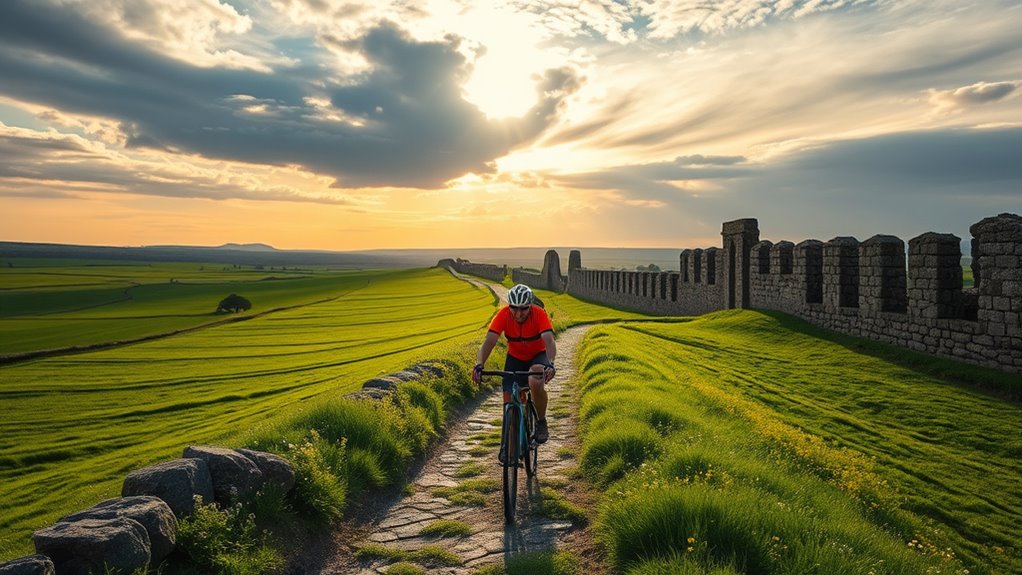
Cycling along Hadrian’s Wall immerses you in the rich tapestry of Roman history and stunning landscapes. Spanning 84 miles, the Hadrian Cycleway invites you to explore ancient forts like Housesteads and Vindolanda, where remnants of Roman architecture stand as proof of a bygone era.
As a history buff, you’ll appreciate the insights into Roman military life and the Empire’s influence in Britain. The route offers picturesque views of the Northumberland countryside, showcasing rolling hills and serene rivers, making each pedal stroke a feast for the eyes. The journey can also be enhanced by choosing the right cycling gear that suits your adventure style.
With well-marked paths accessible for cyclists of all skill levels, this journey is an engaging blend of history and nature, ensuring you create unforgettable memories along the way.
The Camino De Santiago: a Journey of Pilgrimage and Reflection
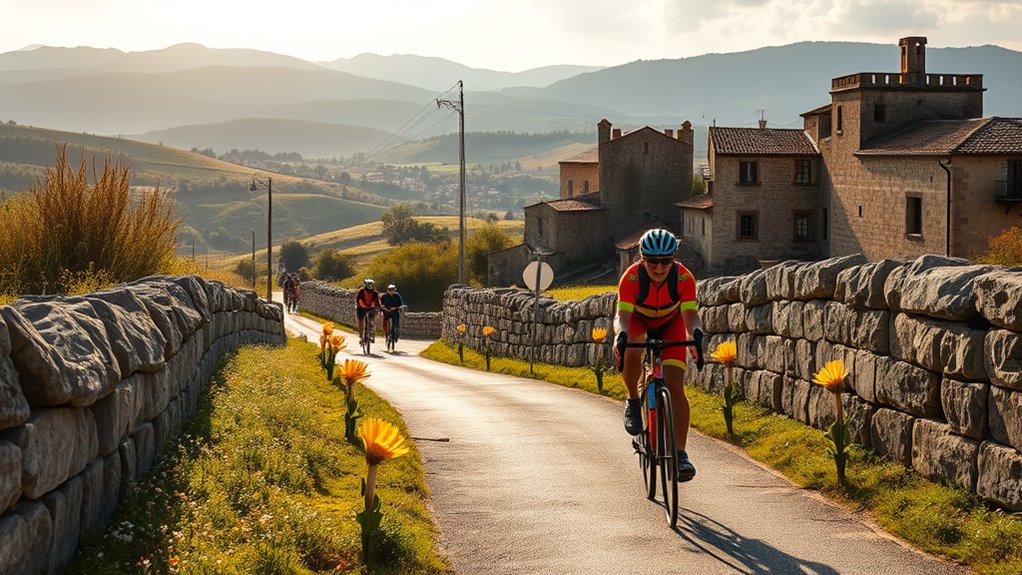
As you cycle along the Camino de Santiago, you’ll not only traverse stunning landscapes but also step into a rich tapestry of history and culture. This journey invites you to reflect on your own experiences while exploring the deep spiritual significance that has drawn pilgrims for centuries. Embrace the opportunity to connect with the diverse heritage of the regions you pass through, making each pedal stroke a personal exploration. Along the way, consider how the principles of emotional alignment can enhance your journey and foster a deeper connection to both the path and yourself.
Historical Significance of Pilgrimage
While many might think of the Camino de Santiago solely as a cycling route today, its historical significance as a major pilgrimage path can’t be overstated. This journey has attracted countless pilgrims seeking spiritual fulfillment for centuries.
- Pilgrims believed that completing the trek would reduce time spent in Purgatory.
- The path features diverse landscapes and historic regions, especially in Galicia.
- It symbolizes faith and reflection, drawing modern pilgrims and cyclists from around the world.
Cycling the Camino allows you to connect with this rich history while embracing the physical adventure. As you ride, you’ll not only traverse a beautiful route but also walk in the footsteps of those who sought spiritual enlightenment throughout the ages. Moreover, the experience can enhance your personal expression as you reflect on the journey’s deep-rooted cultural significance.
Cultural Heritage Exploration
Exploring the Camino de Santiago offers you a unique opportunity to immerse yourself in centuries of cultural heritage.
As you cycle the iconic Camino Francés, stretching about 780 kilometers from St. Jean Pied de Port to Santiago de Compostela, you’ll encounter ancient monasteries and churches that echo the spiritual journeys of countless pilgrims.
This historic route, recognized as a UNESCO World Heritage site, highlights the rich traditions of the regions you traverse.
Just as the Silk Road connected diverse cultures, the Camino fosters a sense of unity among those who travel its paths.
Each stop along your journey reveals local customs and stories, enriching your understanding of the cultural tapestry that defines this remarkable pilgrimage. Additionally, the rise of sustainable fashion encourages travelers to consider eco-friendly practices during their journeys.
Personal Reflection Opportunities
The journey along the Camino de Santiago isn’t just about the physical act of cycling; it’s also an invitation for personal reflection and introspection.
As you pedal through the historic landscape, consider the following personal reflection opportunities:
- Connect with the stories of past pilgrims and their struggles.
- Engage with local communities that share their traditions and wisdom.
- Contemplate your own journey and what it means to you.
Each mile offers a chance to reflect on your personal narrative against a backdrop of centuries-old history.
The Camino de Santiago encourages you to discover deeper meanings in your life, inviting spiritual growth as you navigate the path that countless others have traveled. Additionally, consider how personalized learning can enhance your experience, allowing you to adapt your journey based on your unique reflections and insights.
Embrace this unique opportunity to explore both the external world and your inner self.
Historical Cycling Tours in Europe: Exploring the Past on Two Wheels
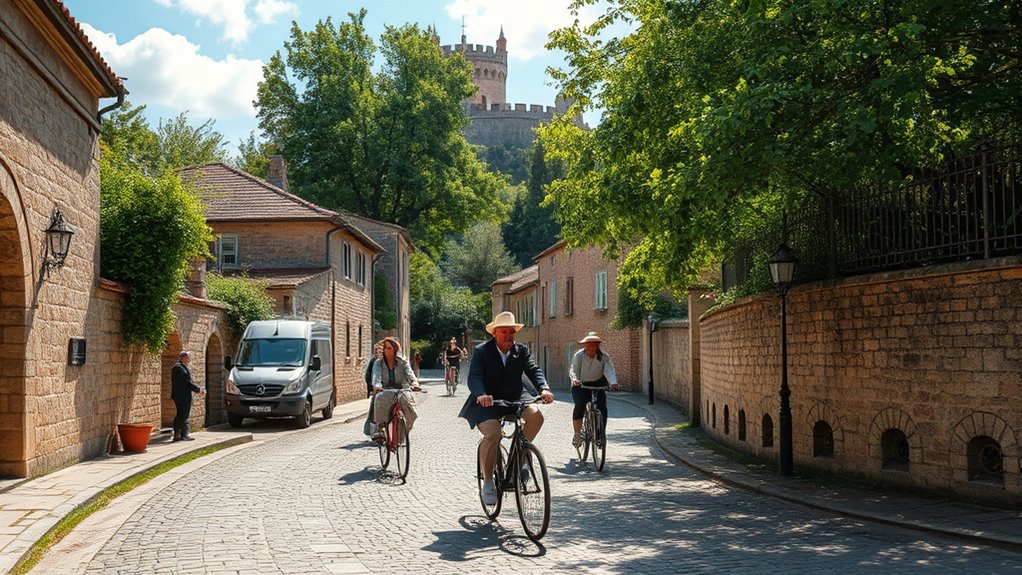
When you hop on your bike to explore Europe’s historical routes, you’re in for a journey through time.
From the Camino de Santiago to the Hadrian Cycleway, each ride connects you with the rich cultural heritage and iconic landmarks of the past.
Get ready to uncover stories and sights that shaped history while enjoying the open road. Additionally, understanding the narcissist-borderline dynamic can enhance your emotional resilience as you navigate through the complexities of relationships along your travels.
Iconic European Cycling Routes
Cycling through Europe offers a unique chance to connect with history, as many routes trace the footsteps of ancient civilizations and significant events.
Here are a few iconic cycling routes that highlight Europe’s rich past:
- Ruta de La Plata: Connects UNESCO sites and Roman ruins, blending commercial and pilgrimage history.
- Hadrian Cycleway: Follows Hadrian’s Wall, showcasing Roman architecture and fortifications across 84 miles.
- Camino de Santiago: Once a pilgrimage path, now a cycling journey through Galicia’s heritage.
Additionally, cyclists should remember to stay hydrated by locating nearby water sources, ensuring a safe and enjoyable journey.
Each of these routes not only reveals stunning landscapes but also immerses you in war history, ancient trade, and cultural evolution.
Cultural Heritage Exploration
Exploring Europe’s rich tapestry of history becomes even more engaging when you hop on a bike, allowing you to connect with landmarks that tell stories of the past.
As an avid cyclist, you can set out on historical tours that reveal cultural heritage exploration at its finest. Picture yourself cycling along the Camino de Santiago, absorbing Galicia’s architectural wonders, or tracing the routes of Operation Market Garden, where history comes alive at every marker.
The Via Claudia invites you to experience ancient Roman trade routes, while the Siem Reap Angkor Temples Bike Tour showcases the grandeur of the Khmer Empire. Cycling through regions with cultural festivals enhances your journey by linking you to local traditions and celebrations.
These journeys not only enhance your cycling experience but also deepen your appreciation for the historical narratives woven into Europe’s landscapes.
Notable Cycling Tours in the United States and Asia

While traveling through the United States and Asia, you can uncover the rich history and culture of each region by taking part in notable bike tours.
These experiences not only educate but also create lasting memories with friends and family. Here are some highlights:
- Atlanta’s Journey for Civil Rights Bike Tour: Explore pivotal sites like Dr. Martin Luther King Jr.’s birthplace.
- Siem Reap’s Angkor Temples Bike Tour: Cycle through the breathtaking architectural wonders of the Khmer Empire.
- Washington DC’s Monuments & Memorials Bike Tour: Visit iconic landmarks, including the Washington Monument and memorials dedicated to influential figures.
These tours provide a unique way to connect with history, fostering a deeper understanding of cultural heritage while enjoying the outdoors with loved ones.
The Impact of Historical Cycling Tours on Personal Connections
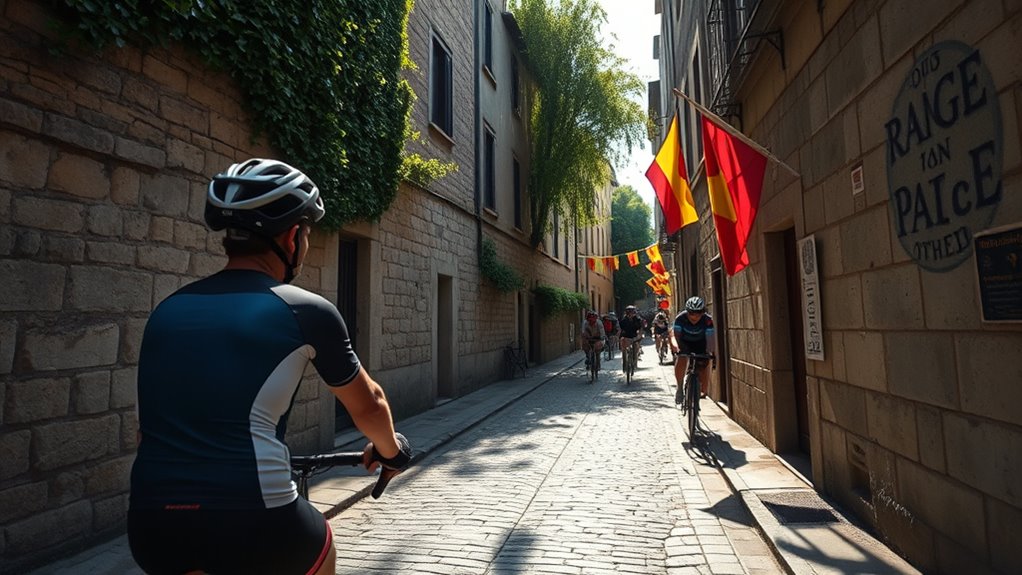
When you join a historical cycling tour, you’re not just pedaling through scenic landscapes; you’re exploring your ancestral heritage.
As you visit significant sites and hear personal narratives, you’ll foster emotional connections that bring history to life.
This shared experience with fellow riders deepens your understanding of the past and strengthens your sense of belonging.
Ancestral Heritage Exploration
Historical cycling tours offer a unique opportunity to forge personal connections with your ancestral heritage as you navigate routes steeped in significance.
During your bike ride, you might:
- Explore landmarks your ancestors once visited, deepening your sense of belonging.
- Engage with local guides who share stories that bring history to life.
- Reflect on your family’s past while cycling through regions tied to pivotal historical events.
As you pedal along paths like the Camino de Santiago or the Ruta de La Plata, you gain firsthand experiences that enhance your understanding of your cultural identity.
This blend of physical activity and historical exploration makes your heritage accessible, allowing for emotional connections that resonate long after the ride ends.
Embrace the journey!
Personal Narratives Uncovered
As you navigate the winding paths of history on a bike, personal narratives come to life, revealing how your ancestors’ stories intertwine with significant events.
Cycling tours, like Atlanta’s Journey for Civil Rights, allow you to uncover the struggles faced by communities during the Civil War. Each pedal stroke brings you closer to memorials and monuments that echo the sacrifices of your forebearers, deepening your understanding of their experiences.
Similarly, the Operation Market Garden route highlights local residents’ stories, connecting their past with your present. These encounters encourage you to reflect on legacy, prompting a sense of belonging as you grasp the emotional weight of historical events.
Your ride becomes a powerful journey through both history and personal identity.
Emotional Connections Fostered
Cycling through history can spark profound emotional connections, transforming your ride into a journey of self-discovery. As you navigate historical routes, you’ll uncover layers of personal narratives tied to significant events, deepening your connection to the past.
- Experience the resonance of local battlefield tours that honor sacrifices made during the World War.
- Witness poignant ceremonies at gravesites, where personal stories intertwine with history.
- Reflect on the shared legacy fostered by Dutch families adopting the graves of missing U.S. soldiers.
These experiences not only enrich your understanding of cultural identities but also prompt a powerful reflection on the struggles and triumphs faced by your ancestors, creating lasting emotional bonds along the way.
Bart Verhulst’s Cycling Initiative: Remembering Operation Market Garden
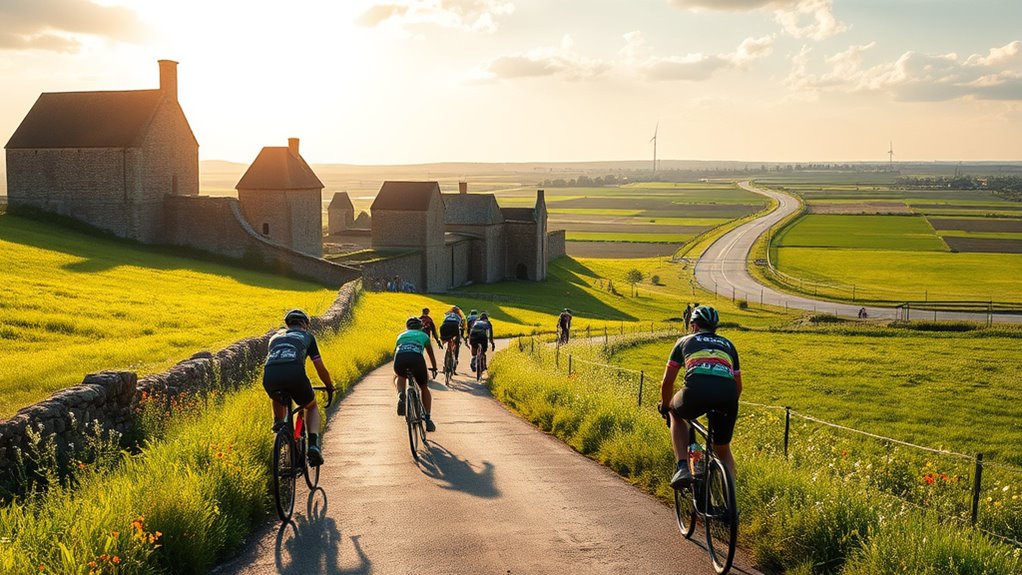
When you explore Bart Verhulst’s cycling initiative, you’ll discover a unique way to honor the legacy of Operation Market Garden. Launched on marketgarden.cc, this initiative features five cycling routes ranging from 83 to 137 miles, starting in Leopoldsburg, Belgium, and ending in Arnhem.
Each route highlights historical markers, monuments, and museums, making the history accessible to younger generations. Verhulst’s passion began in 2017, sparked by a mural along Hells Highway.
Local battlefield tour guide Joris Nieuwint enriches the experience with personal stories, often shared with relatives of soldiers who participated in the operation. While the operation is often deemed a failure, its local impact remains significant, and this initiative keeps its memory alive through cycling.
The Emotional Resonance of Battlefield Tours in the Netherlands
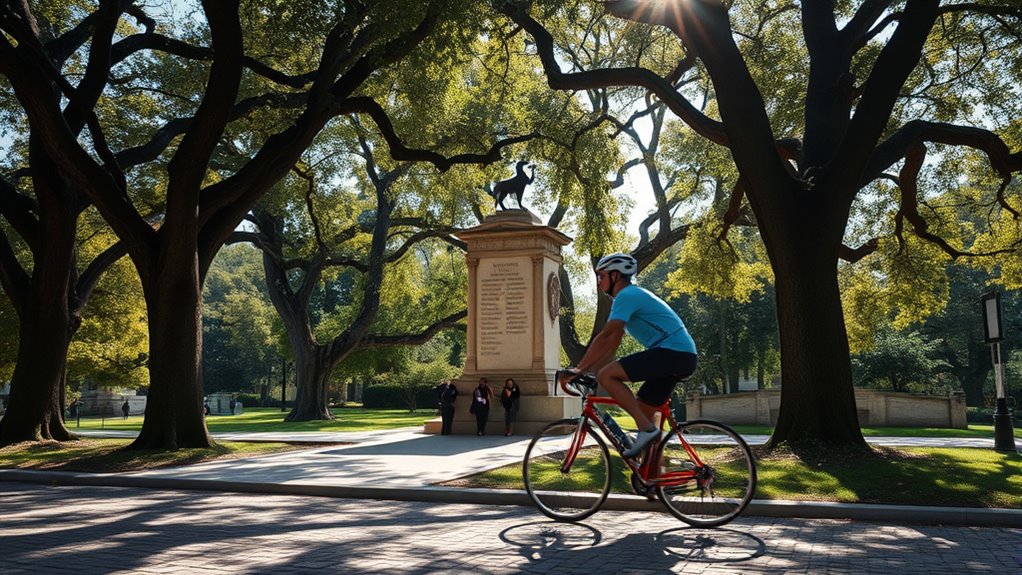
Exploring the emotional resonance of battlefield tours in the Netherlands reveals a profound connection to history, especially for those following the path of Operation Market Garden.
- Experience the bravery of soldiers from the United States who fought valiantly during World War II.
- Hear personal stories from local guides, sharing memories of residents who lived through these tumultuous times.
- Visit the Netherlands American Cemetery and Memorial, where Dutch families honor the legacies of missing U.S. soldiers.
As you cycle through these significant sites, you’ll feel the weight of history and the poignant sacrifices made.
Ceremonies at gravesites create a reflective atmosphere, helping you appreciate the impact of war on both soldiers and civilians alike, ensuring their stories are never forgotten.
Cycling as a Means to Connect With Ancestral Histories
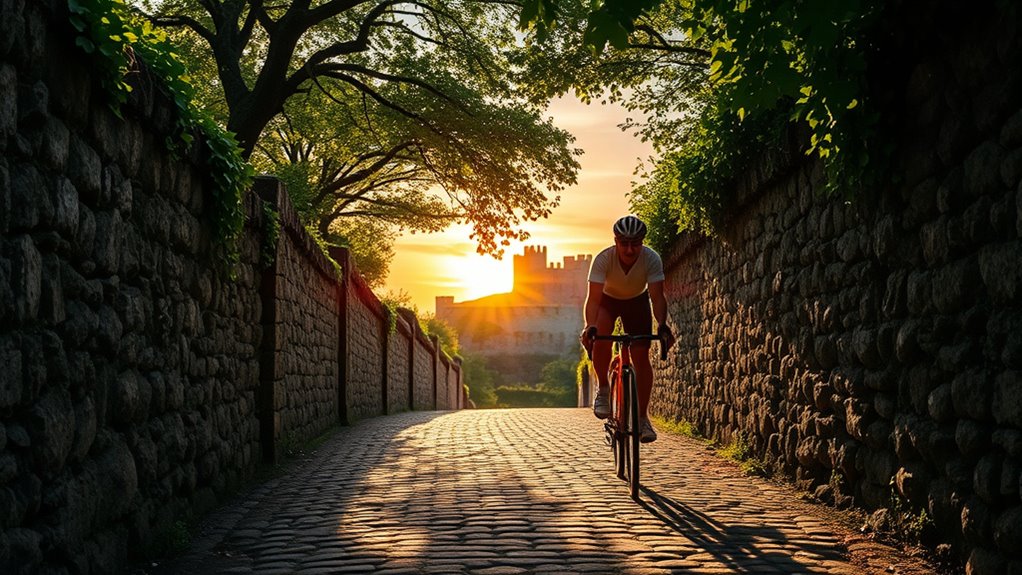
As you pedal along historic routes, you can feel a deep connection to your ancestors and their journeys, discovering the paths they once traveled for spiritual fulfillment or trade.
Take a look at the Camino de Santiago, where modern pilgrims echo the footsteps of those seeking enlightenment in the Middle Ages. Cycling the Ruta de La Plata immerses you in ancient trade routes, revealing the cultural heritage of cities like Cáceres and Merida.
Similarly, Bart Verhulst’s cycling initiative along Operation Market Garden links riders to World War II narratives, often tied to family histories.
Historical tours like the San Antonio 3 Spanish Missions Bike Tour showcase how communities evolved, allowing you to reflect on personal histories and appreciate the struggles of previous generations.
Frequently Asked Questions
What Is the Worlds Most Famous Cycling Event?
The world’s most famous cycling event is unquestionably the Tour de France. You’ve likely heard of it, as it captivates millions each year.
Established in 1903, this grueling race spans around 3,500 kilometers across stunning French landscapes. Riders tackle challenging mountain climbs and flat stages, all while vying for the prestigious yellow jersey.
You can’t help but feel the excitement as elite cyclists push their limits, making it a highlight in the sports calendar every July.
What Is the 75 Rule in Cycling?
Imagine pedaling effortlessly, the wind whipping past you, as you find your rhythm.
That’s where the 75 Rule comes in. It suggests you aim for 75 revolutions per minute (RPM) to boost your cycling efficiency and stave off fatigue.
By maintaining this cadence, you enhance your endurance and power output, allowing for a smoother ride over long distances.
Who Is the Most Famous Cyclist in History?
When you think of the most famous cyclist in history, Lance Armstrong often comes to mind. His seven consecutive Tour de France wins captivated millions, but his legacy took a hit due to doping scandals.
However, you might also consider Eddy Merckx, known as “The Cannibal,” who’s celebrated for his incredible achievements.
Each cyclist brings a unique story, but Armstrong’s rise and fall leaves a lasting impression on the sport.
What Is the Most Famous Bike Ride in the World?
The most famous bike ride in the world is arguably the Camino de Santiago.
As you pedal through its scenic paths, you’ll join thousands of pilgrims heading to the iconic cathedral in Santiago de Compostela, Spain.
This journey not only offers breathtaking views but also a rich tapestry of history and culture.
Whether you’re seeking adventure or spiritual fulfillment, you’ll find that the Camino de Santiago has something special for every cyclist.
Conclusion
As you pedal along the Ruta De La Plata, the ancient stones whisper tales of silver traders, while the vibrant breeze carries the laughter of modern cyclists. Each turn on the Camino De Santiago mirrors your own journey of self-discovery, contrasting the weight of history with the lightness of the present. In this dance of past and present, you find connection—not just to the roads beneath your wheels, but to the lives that once traversed them.
